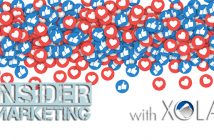Let’s forget, for the moment, the recent dents and scratches on Facebook’s public relations and reputation. For businesses, there was a more significant development that took place in January 2018. That’s when Facebook announced it would change the news feed algorithm to prioritize content from “friends, family, and groups” over, say, commercial interests.
Facebook founder Mark Zuckerberg stated, “You’ll see less public content like posts from businesses, brands, and media. And the public content you see more will be held to the same standard—it should encourage meaningful interactions between people.”
This announcement by Facebook was a shock to the business community, which spends millions of dollars on Facebook advertising and had also relied on the platform to easily reach its followers organically, i.e., for free. How would this impact news feed and in-page advertising and engagement, along with advertisers’ return on ad spend?
A year later, we know there are still plenty of things you can do to help your Facebook content reach as many people as possible, without paying a dime. And for a few bucks here and there, the platform offers several opportunities to make an even greater impact, with high ROI.
FACEBOOK ALGORITHM TOP-RANKING FACTORS
Top-ranking factors are associated with determining the relativity of content, and if the content will be pushed to the news feed. In other words, if these factors are applied and/or occur on content you post, more people will likely see it. The factors:
COMMENTS. Businesses should create quality content focused on engaging conversations between users. Do this by posing questions in posts. Also, write about timely, relevant topics that users are sure to have an opinion on. Know your audience. Publish content that resonates with them and speaks to your business’s brand, culture, values, and beliefs.
REACTIONS. If a Facebook fan reacts to your post using one of the newish reaction icons—“Love,” “Ha-Ha,” “Sad,” “Wow,” or “Angry”—instead of the traditional “Like,” your content might receive a boost in the news feed.
COMMENT REPLIES. The algorithm favors comments and replies to comments. These signal that a piece of content is motivating fans to act and engage with the content.
SHARING LINKS OVER MESSENGER TO A GROUP OF FRIENDS. It’s good if a user shares a piece of content to their wall, but if a user takes the time to send it to a friend over Facebook Messenger, the algorithm favors that interaction.
ENGAGEMENT ON SHARES. Shares are good, but not enough by themselves. Your post must be shared and get engagement on that share to be favored by the algorithm.
TIPS TO INCREASE ORGANIC REACH
FOCUS ON VIDEO. Video is a top priority for publishing on your business Facebook page, and Facebook Live video is even better. To maximize the reach of the content, plan and schedule the use of Facebook Live at your adventure park or zip line tour. Feature staff members in live updates for a truly genuine look at what guests can expect. Also, showcase guests during their experience—with the guests’ permission, of course. This not only makes for terrific promotional content, but Facebook will also push it to more of your followers’ news feeds, and more eyes will see it.
AVOID ENGAGEMENT BAIT. Asking your fans to comment or like a post is engagement bait, and Facebook is not a fan of this.
FOCUS ON COMMUNITY-BUILDING THROUGH FACEBOOK GROUPS. Because Facebook Groups already operate based on audience engagement, utilizing groups for marketing can improve engagement. Facebook Groups provide a space to communicate about shared interests with certain people. You can create a group for anything—and customize the group’s privacy settings depending on who you want to be able to join and see the group. Launching a Facebook Group for special events or special tours that you offer could work well, too.
CREATE QUALITY CONTENT. Publishing content that resonates with your audience continues to be the best approach to fostering meaningful engagement. This content should be aligned with your brand experience and show what guests can expect from your adventure park or zip line tour. This includes eye-catching scenic images and videos.
CONNECT WITH INFLUENCERS. A Facebook influencer is someone with established credibility and a large, engaged following that overlaps and aligns with your brand’s target audience. Searching out and utilizing influencers to post to their page on your business’s behalf could help increase engagement and followers.
To find influencers, a good place to start is with your own Facebook page fan base. Look for advocates who have a medium to large following that appears to be aligned with your brand or destination. Keep in mind the audience you’re targeting—local or destination—when engaging with influencers.
Yes, an influencer might expect to be paid to promote your adventure park or zip line tour on his or her Facebook page, so it isn’t exactly “organic,” but it all depends on the person.
ENCOURAGE CUSTOMERS TO FOLLOW YOUR PAGE. Utilize guest touch points to prompt your guests to follow your Facebook page. How? Place a message in booking confirmation emails or post-tour follow up emails. Your booking engine/reservation platform company might be able to assist with this. Onsite signage works, too.
FACEBOOK ADVERTISING: NEW GUESTS, NEW REVENUES
Utilizing Facebook paid advertising with boosted posts, or using the Facebook ads platform to market, can be a very powerful tool with high return. It is not uncommon for us to see a 20X to 30X return on ad spend for our clients’ advertising on Facebook.
Facebook ads come in many shapes and sizes. Which ones work best? After lots of testing, we have discovered several top-performing ad formats for our activity and tour clients, and the creative that will help convert lookers into bookers.
INSTANT EXPERIENCE ADS. Instant experience ads (IEA, formerly known as canvas ads) have proven to be top conversion drivers in Facebook. These full screen ads are a combination of several elements: an image or video, a carousel of images, two description areas, and two custom call-to-action (CTA) buttons. These ads are extremely versatile and allow you to showcase a variety of creative elements to grab the attention of your audience.
Another advantage: when the user scrolls to the end of the ad’s canvas, your website automatically opens. This ad format was specifically designed for mobile use, which is increasingly where most travel-related experiences are being booked.
We recommend using a 15- to 60-second video as the main creative piece to entice the user to open the canvas and see more. The ability to include a carousel within the canvas also enables you to showcase more images. Always use experience-based images that will excite your customers and show them what they will get when they book with you.
Customizable CTA buttons allow you to speak directly to your audience. For example, “Book Your Unforgettable Experience Today” plays better than the generic “Book Now” CTA.
CAROUSEL ADS. Carousel ads are usually the next best converting ad format. These allow you to showcase several images or videos in one ad, which users can then scroll through. Each card of the carousel gets its own headline and destination URL.
One fun way to encourage users to scroll through the carousel is to break a panoramic image into several cards, so the user needs to scroll through the carousel to see the whole image. This helps improve ad engagement rates and, therefore, improves your relevance score.
IN-STREAM VIDEO ADS. If you have access to powerful and memorable video content, in-stream video ads are a great option. These are ads that play during other video content that your audience is viewing on Facebook. These ads must be 5 to 15 seconds long, and only work with certain campaign objectives (reach, awareness, video views, and engagement).
The in-stream video ad format is best for a fresh audience that hasn’t yet been to your site. Regular news feed videos from 15 to 60 seconds can work well for remarketing audiences.
FACEBOOK VIDEO BASICS
BRANDING. For all videos on Facebook, make sure you include your brand in the first 3 seconds of the video to ensure that it sticks with viewers. It’s also a good idea to include the website URL with a CTA at the end of the video.
20 PERCENT RULE. Keep in mind that the 20-percent text rule applies to videos just as for images. That is, no more than 20 percent of the video frame (or photo) used for an ad can be occupied with text. Otherwise, Facebook may reject your ad.
HIGH QUALITY. High-quality video and images are essential for Facebook advertising to draw in your audience. Use text to explain the experience and any benefits you can provide that your competitors can’t.
REMARKETING. Facebook can be a great place to run a promotion for website visitors who didn’t convert, or for cart abandoners to get them to come back and complete a purchase. Use the Facebook business pixel on your website to bucket and remarket to people who have started a checkout process but did not complete a booking.
Use the right ad formats and creative, and Facebook is a great tool to turn lookers into bookers. Don’t have the time or experience to take advantage? Engage a Facebook advertising professional or digital marketing company with deep experience in managing Facebook advertising for activity and tour companies. Done right, Facebook advertising and marketing can be spectacularly effective.






